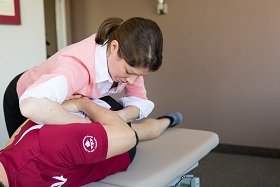Stretching for Injury Prevention and Performance in Sport
Some may find stretching to be boring, others find it satisfying and relaxing. Regardless of how you feel, the role of flexibility is critical.
Athletics Canada defines flexibility as the ability to perform movements at a joint with appropriate range of motion. Flexibility may not be the main focus of many train programs but improvements in flexibility aids with injury prevention, helps minimize soreness and improves efficiency in all physical activities. Stretching should be part of all athletic and individual training programs, but the degree of flexibility that an individual needs depends on the type of activity being performed and body parts involved.
How can I improve my flexibility?
Flexibility can be improved by making it part of your regular workout routine by stretching muscles properly before and after exercising. Before exercise it is important to perform a warm-up, as warm muscles are looser and less likely to be strained than cold muscles. The type of stretching performed depends on what your goal is:
Before exercise (part of warm-up)
Dynamic stretching involves lengthening a muscle with a movement such as a repeated lunge or a toe touch. It often involves sport-specific movements to prepare the body for activity or competition.
- Focuses on movement patterns that require a combination of muscles, joints, and planes of motion
After exercise (part of cool down)
- Static stretching is a constant stretch held at an end point for 30-60 seconds.
- Was commonly used during the warm-up but now recommended during cool down
Special cases
- Ballistic stretching involves active muscle effort and uses fast bouncing-type movements to increase the range without holding the stretch at an end position. This is sometimes used in combat sports to prepare the body for impact.
§ Not recommended for individuals with minimal training background or prone to injury
Are there other methods of stretching?
In addition to dynamic and static stretching, Yoga and stability routines are great exercises to strengthen and stretch muscles. Alternatively, the use of a foam roll, massage ball or massage stick can massage the muscles to release muscle tension. Massaging with tools like these may cause some temporary soreness but you'll get better results compared to stretching alone. A registered massage therapist is able to check for muscle imbalances and help loosen tight muscles.
Should I stretch in the morning or the evening?
Stretching is a great activity to perform whether it is the morning or the evening. A stretch routine in the morning can help you limber up and get ready to take on the day, especially if you wake up with stiff muscles. You can warm-up muscles up passively by taking a hot shower or bath before stretching. Completing a stretching routine before bed can be used to relax your body and mind to help assist in having a better sleep and decreasing stress. Keep in mind that stretching without a warm-up is better than not stretching at all. If you're pressed for time, just stretch.
Can I do the same stretches for running and soccer activities?
Stretching should ideally match the sport or activity. Many of the stretches can be the same but a soccer warm-up should include sport specific drills. This could be lateral shuffles or cross over steps, backwards jogging, dribbling the ball, pivots and jumping. Some recent research is suggesting that stretches for running should be done after you've finished your run. In this case, you can warm up your body by starting off your run with 5 minutes of very easy pace.
How do I know if I should do stretches or just a light jog to warm-up?
Stretching muscles as a warm-up won't increase muscle temperature or prepare the body for physical activity. You have to get your heart pumping. Light jogging for 5 to 10-minutes will increase muscle temperature so your stretches will be more effective. Warm muscles are more elastic and less likely to be injured.
What should I do if I have pain when I stretch?
Stretching should not be painful, although there may be some discomfort when stretching a tight muscle. If a stretch is painful you may want to do a longer warm up (more jogging) and then try a different stretch for the same muscle. If you've felt the same pain week after week despite trying to stretch it out, consult a kinesiologist to learn better warm up routines and more effective stretches or see a physiotherapist or athletic therapist to determine the exact cause of the pain.
Where can I get more information?
Improving your flexibility can help you improve performance and reduce risk of injury. For a personalized flexibility routine, call our clinic (613-521-3222) and speak with David Witiluk, Certified Kinesiologist.
Additional Resources
- www.ottawaosteopath.com
- www.youtube.com/user/OttawaSportsInjuries (Dynamic stretching videos)
General Recommendations
- Warm up with 5-10 minutes of easy jogging
- Use dynamic stretches during the warm-up
- Include all major muscle groups
- Do more than one stretch for each joint
- Use static stretches during the cool down









